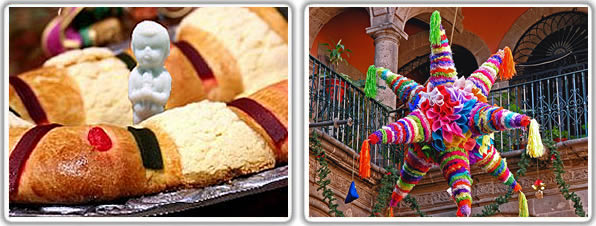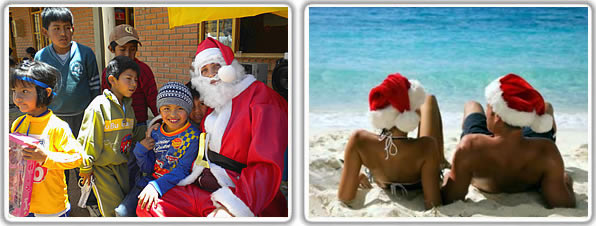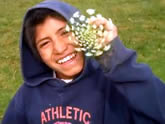Categories
Links
Archives
Tag Cloud
One language, different ways of celebrating Christmas in Latin America
Author: adminViews 17.530 19 dic
Christmas in Latin America known as Navidad is one of the most important events in the year. It is celebrated with even more devotion than in other parts of the world due to the omnipresence of Christianity; after all, Christmas is centered around the age-old story of Jesus’ birth on the 24th of December.
For most Latinos it is very much a religious holiday with families attending together the Misa de Gallo (Mass of the Rooster because it usually finishes at 1 am when the rooster announces the coming day). Christmas Eve or Noche Buena really is the time of giving, but many Latin American families also keep alive the Día de los Tres Reyes. Those children who have behaved themselves well will receive a second round of presents on January 6th from the Three Wise Men, just like they did after Jesus was born.
Besides all the similarities, there is great influence from the different indigenous people of the region and many Latin American cultures hang on to their own curiosities during Christmas time:

Chile
In Chile they do a toast with a monkey’s tail. Not what you might think, but the cola de mono is a traditional Christmas cocktail made with milk, coffee, sugar, cinnamon and brandy. Father Christmas is known as Viejito Pascuero who wishes everyone a Feliz Navidad. And at New Year’s Eve they have the habit to burn huge dolls made out of old clothes, paper and wood with the fire supposedly eradicating all the bad and purifying the start of the New Year.
Peru
Predominantly in the indigenous regions of the country, it is not uncommon to see a roasted guinea pig (cuy) or suckling pig (lechón) on the menu instead of turkey. You can also witness retablos popping up everywhere; these artistically decorated portable altars are small wooden boxes depicting religious scenes such as the birth of Jesus surrounded by Andean pastors.
Costa Rica
In Costa Rica, models of Christ’s birthplace are no small clay figures known as pesebres to be placed under the Christmas tree but life-size effigies that fill a complete room, or stable in this case.
Dominican Republic
Here, Santa has competition in the form of la Vieja Belén. This mythical old lady comes around the Sunday after Día de Los Reyes to give humble but meaningful presents to children of poorer upbringings that didn’t receive much from Baby Jesus and the Three Wise Men. The gifts tend to be smaller because she is an old lady not able to carry heavy presents.
Guatemala
Saints are being paraded through the streets all year round, and Christmas is no exception except that God himself is the center point of attention. The white-bearded statue does, oddly, remind you of Santa Claus in the Western world. The extravagant processions are accompanied with loud jingles produced with chirimias flutes and marimbas.

Venezuela
It is custom that Venezuelan worshippers are being lifted from their bed in the very early hours with firecrackers and bell ringing to make them attend one of the posadas or carol services. When the children wake up on January 6th, they might find that the straw they had left beside their bed has been replaced by gifts left behind by the Magi and their camels and when they look in the mirror they should not wonder why they have a black smudge on their cheek; a sign that Balthazar, King of the Ethiopians has kissed them during their sleep.
Mexico
During Christmas Eve, the Mexican kids will be blindfolded and have a go at hitting a brightly decorated piñata that swings in the air at the end of a rope. Once it breaks all children jump up to gather the candy that was inside the piñata.
When the three wise men come around in January it is also time to part the Rosca de Reyes, a delicious oval sweetbread decorated with confectioned fruit and served along with regional fav’s such as corn tamales and hot chocolate. Hidden inside the Rosca is a plastic figurine of Baby Jesus. Each guest carefully cuts and inspects their slice (with the knife symbolizing the danger Jesus was in of being discovered by King Herod). Whoever gets the baby figurine has to play host and invite everyone present to yet another celebration on February 2 known as Misa de Candelaria with more tamales and hot chocolate.

Argentina
Food is central during the family Christmas celebrations in Argentina. Mothers make different kinds of dishes such as roasted turkey and pork, stuffed tomatoes and mince pies. The table is also covered with sweet things such as puddings and a punch prepared with fruit pieces, juice and cider for the traditional brindis at midnight.
Probably the strangest phenomenon during Christmas in Latin America is to see Santa Claus wearing only silk clothes, or shorts and sandals. It is the height of summer in the Southern Hemisphere and good old Santa prefers to leave bikinis and beach volleyballs under the tree instead of woolen socks.
While people in Europe and North America find the glowing chimney the nicest place to gather, Latinos prefer the beach and outdoor barbeques and rather just ‘dream of a White Christmas’.
Volunteer Work Latin America will also make this Christmas a time of happiness and compassion for many children in need through the selfless commitment of our volunteers. For more info contact us here!




20 Responses for "One language, different ways of celebrating Christmas in Latin America"
In Guatemala they also like to burn things, at the Quema del Diablo everything that is associated with misfortune, including old newspapers collected over the year, is set on fire.
Unlike Mexicans who have adopted the poinsettia flowers known as “Noche Buenas”, which have a perfect red star-shaped bloom, the Paraguayans traditionally fancy the flor de coco to decorate their homes, schools and churches. The very strong smell of this aromatic flower dominates the streets and is a true sign of Christmas and joy.
We are in Peru now volunteering with VLA..we are very glad to have chosen Cusco as it is wonderful place to be for Christmas! Groetjes!!
lol so funny that christ doll in the cake :p
That cola de mono looks tastyyyy…does it taste like a baileys’?
Thanks for your comments all!! @ Jack, actually it is does have some similiarity however the aguardiente used gives it a unique flavor..typical Chilean!
How I wish I could spend christmas on the beach…nothing but rain and snow here in Switzerland!!
That is a really beautiful piñata..sure my children would love to have one here..might go and look for one in south tucson where lots of mexicans live. Thanks for sharing such an interesting article
I prefer Argentina over Peru as I won’t eat cuy!!!
haha Caroline..you don’t need to when in Peru, actually its more common to have turkey! Often prepared with a filling of cranberry, apple and potatoes
Those Mexicans sure know how to party..or at least stretch it out haha
Those retablos make for nice souvenirs..i imagine they have them with non relegious themes as well?
Hola Wingh! Yes they do actually..any imaginable situation if you look good enough in the handicraft stores in San Blas, Cusco..it is a really popular art form in Peru and for traditional families an heirloom piece of importance. E.g. There are agriculture scenes depicted in some retablos which are prayed upon when the crops need water, etc.
Seems that Mexico and Venezuela have kept their traditions most alive..nice article!
I want a cola de mono, pronto!!
Come to Chile Leon! It’s hard to find a cola de mono cocktail anywhere else in the world..but you can try making one yourself by looking up a recipe..just need the right type of brandy for it to be authentic
What about Brazil?
Hola Sylvia..In Brazil Christmas time is a time of great joy and party..for those living close to the beach most free time is spent there…the menu features more tropical fruits and instead of typical Christmas carrols you here folkloric and rhytmic music. A true feast according to the volunteers that were in Brazil during Christimas time. Hard to not have a good time when you are in paradise!
What if you cut the Rosca and cut the baby Jesus in half?
That normally doesnt happen Drake as the cake is soft and the doll of hard plastic..carefullness is required..the first one who points the knife at Jesus has to play host one month later!
Leave a reply